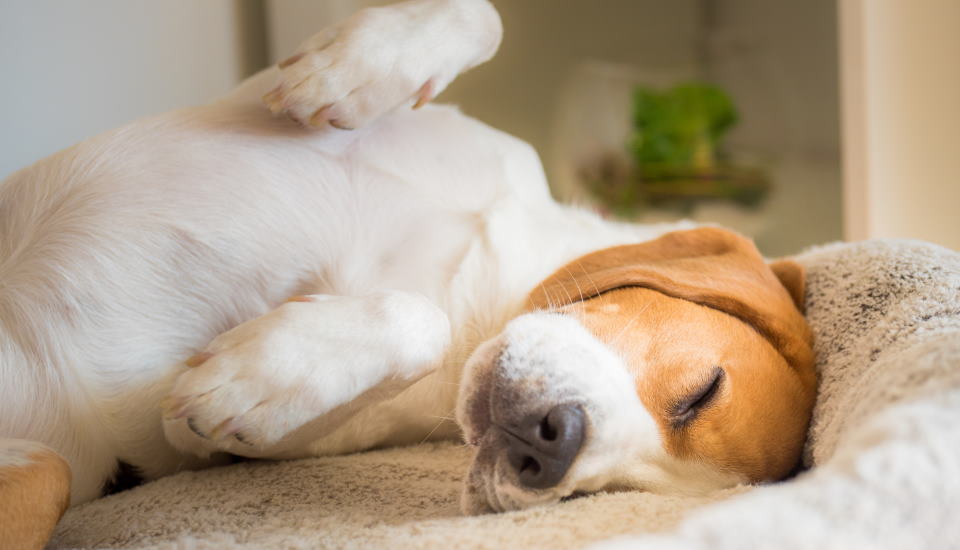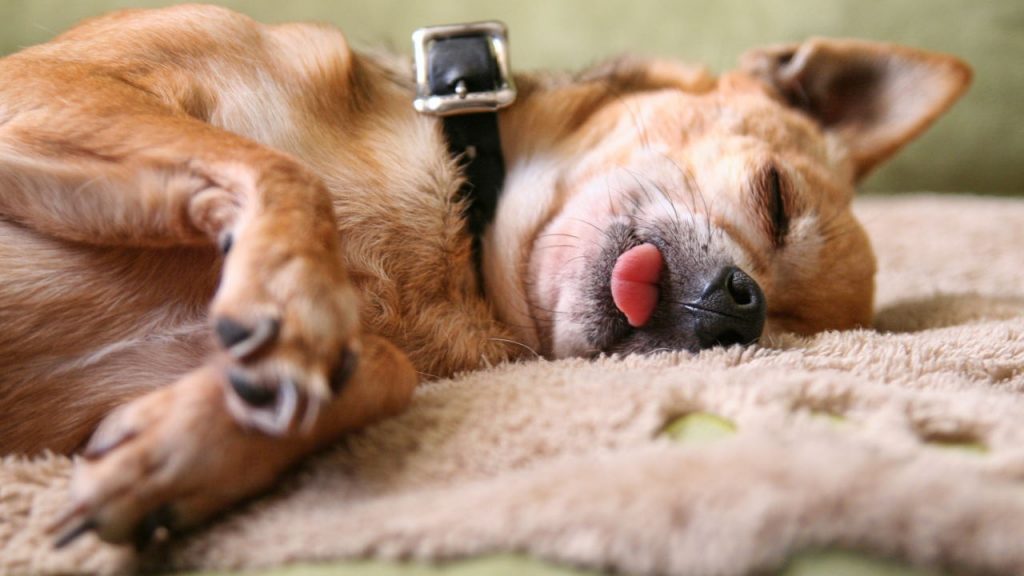When we adopt a dog, we commit our free time to them. As humans, we love to spend our time sleeping or daydreaming. Just like us, our pets like to sleep too. We both love to sleep; however, we can not and should not spend that much time sleeping. We have things to do, we have responsibilities, and we have social lives. Dogs, on the other hand, under everyday situations, can spend their leisure time -which is all of their time- sleeping.
They usually wake up and roam around. And after doing that, they typically go back to sleeping again. In terms of dogs, that is normal. There is nothing to worry about. Do not worry if your pet hides under your bed. Under your bed is a haven. Do not disturb your pet that hides under your bed.
How Long Do Dogs Sleep in a Day?
Even more, than humans do, they require a large quantity of sleep. Because sleep is riskier for prey species, carnivores such as dogs sleep more than herbivores. However, the overall amount of sleep they require varies based on various circumstances. Age is the most crucial factor, as it has the most significant impact on their sleeping patterns.
Puppies

While research on this subject is sparse, one study found that puppies sleep for at least 11 hours per day under normal circumstances. Although puppies sleep less at night than adults, they sleep more hours during the day and for more extended periods altogether. Puppies sleep in crates or kennels for the most part.
Adult Dogs
Most adults require between eight and thirteen hours of sleep per day, with an average of slightly over eleven hours. On the other hand, adults need an average of seven to eight hours of sleep. Adults sleep more at night than puppies under normal circumstances, averaging 60 to 80 percent of the time between 8 p.m. and 8 a.m., depending on their environment and their owner’s schedule. Adults, on the other hand, need midday naps because they can sleep for up to 37% of the day. Most of them sleep in a pet sleep zone by the time they are a year old.
Senior Dogs
Middle-aged and seniors prefer to sleep later in the morning and wake up less frequently at night. They also nap more regularly, so they sleep more during the day.
How Do I Identify If My Dog Sleeps Enough?

They are adaptable to a wide range of settings; for example, according to some research, Shelter dogs sleep less during the daytime, nap more soundly at night and wake up less frequently.
Adapting to a crowded environment, on the other hand, may come at a cost. However, the same study discovered that pets who sleep more during the day are more relaxed and appear happier, so if your fluffy buddy isn’t sleeping well, it’s worth looking into.
The signs of sleep deprivation in them have received little attention. However, anecdotal evidence suggests that they may resemble some of the symptoms of sleep deprivation in humans under everyday situations, such as:
- Stressful stimuli cause more acute reactions.
- Memory problems
- Irritability and mood swings are two of the most common symptoms of depression.
How to Help Your Dog Sleep Better?

Most of them can obtain the rest they require to live happy and contented lives. There are, however, some things you can do to ensure your pet’s schedule and environment are conducive to snoozing.
- Many people allow their pets to rest with them at night, although this can disrupt both human and canine rest habits. These disturbances happen even when owners aren’t aware of them, so you might not realize that sharing a bed makes it difficult for your pet to nap.
- Defined a Schedule: If your pet is having trouble relaxing, a set routine may help. Try sticking to the same schedule each day to see if it helps your pet sleep better.
- While a little study has been done on the association between naps and exercise in dogs, we know that regular exercise appears to help humans rest better. According to anecdotal data, this seems to be true for them, particularly highly energetic working breeds.
- Allow for rest periods throughout the day: Unfamiliar or busy environments, as well as new people, can make it difficult for your pet to rest throughout the day. Ensure they have periods without activity and access to the quiet, familiar areas to help them obtain enough rest.
- Make Their Bed Comfortable: Many people use a box or kennel to keep small puppies contained and encourage them to nap. Whether you keep your pet in a crate as they get older or switch to a fluffy buddy’s sleep mattress, they must nap in a place that provides both comfort and support. A more supportive one may be required for older or those with joint problems.
- Keep Their Sleeping Area Quiet and Dark: Because light affects mammalian circadian rhythms, it’ll be simpler for your pet to rest at night if it’s dark or dim. It’s also easier for them to nap if they aren’t disturbed by loud noises.
Is There Any Aid for Dogs to Sleep Better?

Unfortunately, no such pet sleep aid will be suitable for all pets. Instead, diagnosing and treating the underlying problem is the most prevalent therapy for sleep-related issues.
Pheromone products, like plug-in diffusers, may help calm and quiet those extremely worried. Other ones may benefit from a modest dose of Benadryl to help them relax and rest, but this should only be done with your veterinarian’s approval.
Making the environment nap-friendly is also beneficial. Some of them benefit from a nightlight, and many enjoy listening to music or watching television. However, many prefer to rest in the safe confines of their kennel.
It may take some trial and error to figure out what works best for your dog. Still, with a bit of detective work and the assistance of your veterinarian, most dogs will rest all night soundly.
Why Does My Dog Want to Sleep with Me?
Your fluffy buddy will try to nap close to you at all times. This gives it a more secure feeling. Knowing that they can defend you makes dogs feel more at ease and allows them to dream with more security and peace. Sleeping alongside their owner also releases pleasant endorphins, helping them feel happier and calmer.
Why Does My Dog Sleep Under the Bed?

Your pet could be resting under your bed for a variety of reasons. It’s critical to figure out why you’re resting under the bed if it’s a new habit.
1. They’re Afraid of Something
If your pet is terrified of something, it may retreat to the space beneath your bed to hide. If it’s raining, the house or neighborhood is noisy, they hear fireworks, or there’s a new person in the house, they might be hiding beneath the bed.
I recommend using a soothing voice to help calm pets when they are terrified of something. Removing the source of your dog’s fear can assist in coaxing it out from beneath the bed.
2. They Could be Sick or Hurt
Your dog may be hiding as a means of coping with their distress. When they don’t understand why they’re not feeling well, being beneath your bed gives them a sense of security. If there’s no other apparent reason for them to be napping under your bed, a trip to the vet should be on your to-do list.
Other indications that your pet is in pain or sick include:
- They’ve lost their hunger
- Growling and snarling
- Hide in a place where you can’t be found
- Angry with you or others
- Indoor peeing and pooping
- Being sluggish
- Diarrhea and vomiting
3. They Could be Wanting Privacy

A pet may choose to nap under a bed to have more privacy. If you live in a busy environment or have recently moved, giving your pet a private space may help him feel more at ease. Napping under the bed may create a peaceful, comfortable, and predictable environment for your pet.
4. Stressful Environment
Do you live in a busy house with many kids, have visitors, a new pet, or someone new staying with you? Change or a lot of activity might make some pets feel worried and make them under pressure, so they prefer to hide under furniture or under the bed to feel protected.
The following are some other symptoms that your dog is stressed:
- They’re chewing on their paws.
- Destroying objects while panting.
- Attempting to flee.
5. They Have Something or Have Done Something They Shouldn’t

When dogs do something they shouldn’t, they are aware of it. They will frequently hide in embarrassment or avoid doing anything embarrassing. Your dog may nap beneath the bed because they have a secret cache of something it shouldn’t have.
6. They Want to Be Close to You
If you don’t let your dog nap on the bed, they may lie under it to be closer to you because they don’t enjoy being alone. Likewise, if your dog follows you out of bed, the space under your bed may be picked as a napping area near you.
What Can I Do to Stop My Dog from Sleeping Under My Bed?
If you want to keep your dog out of bed, you must first determine why he is there, and then you can find the solution.
1. Pay a visit to the veterinarian
If there’s no evident cause for concern or any noticeable changes in your dog’s life, you should take him to the vet first. Establish with your vet if your dog is sick; your veterinarian might ask questions or do tests. And take them under observation.
2. Get a Crate for Your Dog

According to some research, dogs without crates may discover space beneath furniture to use as a den.
When your dog needs some alone time or feels uneasy, a crate can provide a haven for them. For example, if your dog has begun to nap under the bed, he might use a crate to replace it. To make a wire crate feel more like a den, I prefer to throw a blanket over the top and place blankets inside.
When your pet recognizes the crate as a haven, they will use it instead of hiding beneath your bed at night.
3. Use Anti-Anxiety Medication
If you notice that your dog is resting beneath the bed due to anxiety or stress, your veterinarian may prescribe medications or therapies to alleviate the tension.
Your veterinarian may recommend the following medications:
- Natural remedies such as pheromones or aromatherapy are examples of CBD oil Valerian root.
- SSRIs, such as fluoxetine or clomipramine, are selective serotonin reuptake inhibitors (SSRIs).
- Selegiline is a drug that is used to treat depression (especially for older dogs)
4. Anxiety Desensitization Training

Desensitization training can help calm your dog if they are anxious about something that won’t alter (such as a new person living in the house). Desensitization training entails introducing your dog to something that makes them nervous at little doses and low intensity.
Exposure to the source of fear regularly and rewarding positive conduct can help people overcome anxiety over time. For example, if your dog gets a reward every time it thunders, it will begin to link thunder with something positive.
5. You Can Give Them Treat When They Come Out
If your dog is resting under the bed, give them a treat if they nap in their dog bed, kennel, or snuggle up on the rug instead. If it begins associating a certain location with sweets, that location will become a source of comfort. When they come out of under the bed, pet them. That will help them to understand coming under the bed is a good act.
Final Verdict
Such as other pets, our fluffy buddies love to nap too. And even they love to nap under your bed. That has several reasons, such as anxiety, privacy, because of afraid, love, stress, pressure, and maybe hurt. It would be best if you were careful of the signs when your pet rests under your bed. Resting under the bed is an an-okay act for them sometimes. Sometimes they sleep under the bed for attention or looking for a haven. Contact your vet if your dog suddenly starts sleeping under your bed. Resting under your bed is their go-to acting. Do not disturb them if they are hiding under your bed. All they want is to be close to you by being under your bed!




